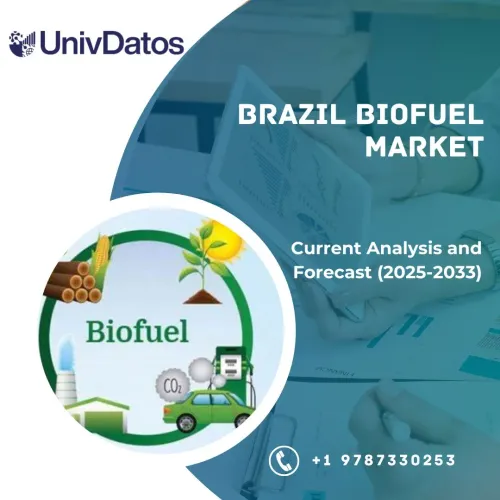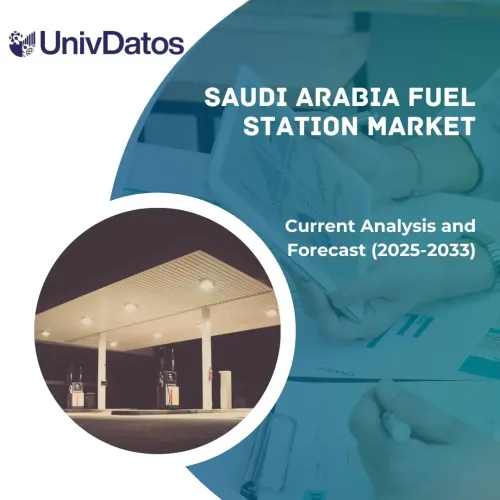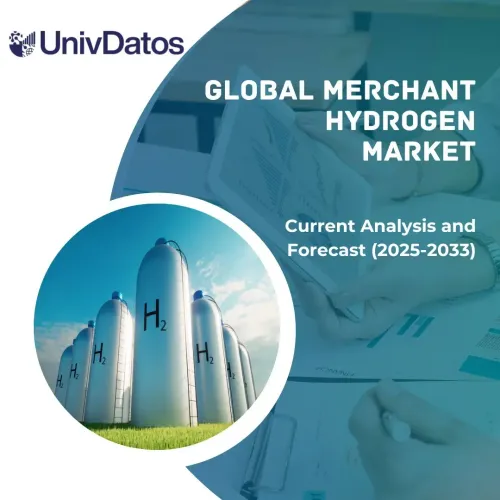- Inicio
- Acerca de nosotros
- Industria
- Servicios
- Leyendo
- Contáctenos
Mercado de Combustible de Aviación Sostenible de América del Norte: Análisis Actual y Pronóstico (2024-2032)
Énfasis en el tipo de combustible (biocombustible y Power-to-Liquid); Tipo de aeronave (alas fijas y aeronaves de rotor); Plataforma (aviación comercial y aviación militar); y País
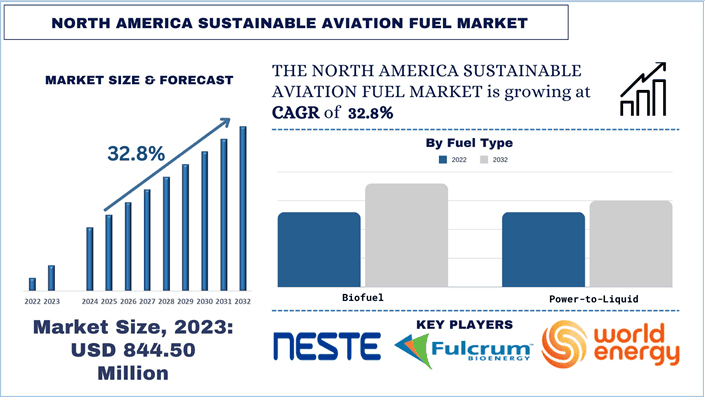
Tamaño y previsión del mercado de combustible de aviación sostenible de Norteamérica
El mercado de combustible de aviación sostenible de Norteamérica se valoró en 844,50 millones de USD en 2023 y se espera que crezca a una fuerte CAGR de alrededor del 32,8% durante el período de previsión (2024-2032) debido al aumento de las regulaciones ambientales y los objetivos de reducción de emisiones.
Análisis del mercado de combustible de aviación sostenible de Norteamérica
El sector del transporte es una fuente importante de emisiones en todo el mundo, incluso en Norteamérica. Hoy en día, la aviación (incluidos todos los movimientos no militares dentro y fuera de EE. UU.) representa el 11% de las emisiones del transporte estadounidense. Estas regulaciones y objetivos buscan inhibir las emisiones de gases de efecto invernadero, mejorar la calidad del aire y defender medidas ambientales sólidas. Además, los países del mundo han definido objetivos concretos para reducir las emisiones de GEI y los objetivos de alcanzar cero emisiones. Estados Unidos se ha fijado el objetivo de lograr cero emisiones netas para 2050, y la adopción de combustible de aviación sostenible es una de las partes fundamentales de este logro. Por ejemplo, el Departamento de Energía (DOE), el Departamento de Transporte (DOT) y el Departamento de Agricultura de EE. UU. (USDA) están lanzando un Gran Desafío de Combustible de Aviación Sostenible a nivel gubernamental para satisfacer la demanda de combustibles de aviación sostenibles trabajando con las partes interesadas para reducir los costos, mejorar la sostenibilidad y ampliar la producción y el uso de combustibles de aviación sostenibles (SAF) que logren una reducción mínima del 50% en los GEI del ciclo de vida en comparación con el combustible convencional. Además, el desafío adoptará el objetivo de suministrar al menos 3.000 millones de galones de SAF por año para 2030 y 2050, SAF suficiente para satisfacer el 100% de la demanda de combustible de aviación, que actualmente se proyecta en alrededor de 35.000 millones de galones anuales. Por lo tanto, con el aumento de las regulaciones ambientales y los objetivos de reducción de emisiones, la demanda de combustible de aviación sostenible tiene un futuro previsible.
Tendencias del mercado de combustible de aviación sostenible de Norteamérica
Bio Jet Fuel a partir de residuos sólidos urbanos
El Biojet Fuel derivado de residuos sólidos urbanos (RSU) es la última tendencia en el mercado de combustible de aviación sostenible debido a sus ventajas únicas. Los RSU son un recurso renovable que se puede convertir en biocombustible a través de diversos procesos, como la gasificación, la pirólisis y la fermentación. Esto da como resultado un biocombustible de alta calidad que se puede utilizar como sustituto de los combustibles fósiles en aplicaciones de aviación. Una de las principales ventajas de los biocombustibles derivados de RSU es la disminución de las emisiones de gases de efecto invernadero (GEI) en comparación con los combustibles fósiles tradicionales. Según el Consejo Internacional de Transporte Limpio (ICCT), los biocombustibles producidos a partir de RSU tienen emisiones de GEI entre un 82 y un 95% más bajas que las de los combustibles fósiles. Además, los biocombustibles derivados de RSU pueden ayudar a reducir la cantidad de residuos enviados a los vertederos, ya que utilizan materiales que de otro modo se desecharían. Además, los biocombustibles derivados de RSU tienen la ventaja de producirse localmente, lo que reduce las emisiones del transporte y estimula el crecimiento económico local. Muchas autoridades de gestión de residuos sólidos urbanos están considerando ahora la conversión de sus flujos de residuos en productos valiosos, como los biocombustibles, en lugar de simplemente deshacerse de ellos en los vertederos. Este cambio de mentalidad ha llevado a un aumento de la inversión en infraestructuras de conversión de residuos en energía y al establecimiento de nuevos modelos de negocio que capitalizan el valor de los residuos como recurso. Por ejemplo, en 2022, American Airlines anunció planes para utilizar biocombustibles derivados de RSU en sus operaciones. La aerolínea se asoció con Gevo, Inc., para producir biocombustibles a partir de tallos de maíz y bagazo de caña de azúcar, dos materias primas no alimentarias.
Norteamérica dominó el mercado de combustible de aviación sostenible de Norteamérica
Estados Unidos posee una importante cuota de mercado en Norteamérica. Los principales factores que impulsan el crecimiento del mercado son la creciente preocupación por las regulaciones ambientales, los objetivos de reducción de emisiones y la volatilidad de los precios de los combustibles convencionales. Además, los avances tecnológicos en el sector del combustible de aviación sostenible han hecho avanzar al mercado en el futuro previsible.
El mercado de combustible de aviación sostenible de Norteamérica está valorado en 844,50 millones en 2023 y se espera que alcance los 13.794,21 millones en 2032 con una CAGR del 32,8%. Los principales factores que impulsan la demanda del mercado incluyen las iniciativas gubernamentales y la colaboración para aumentar las actividades de I+D con el fin de demostrar nuevas tecnologías para lograr al menos una mejora del 30% en la eficiencia del combustible de los aviones. Por ejemplo, la Administración Nacional de Aeronáutica y del Espacio (NASA) ha lanzado la Asociación Nacional de Vuelos Sostenibles para colaborar con la FAA y la industria para acelerar la maduración de las tecnologías de aviones y motores que permitan una reducción radical del consumo de combustible y las emisiones de dióxido de carbono. Además, la FAA introdujo el programa de Investigación Climática de la Aviación (ACR) en 2022, una solicitud de presupuesto presidencial para la FAA con una propuesta de 50 millones de dólares. El programa ACR invertirá en investigación que tenga un potencial de impacto transformador para reducir las emisiones de gases de efecto invernadero de la aviación en apoyo de los objetivos de cambio climático de EE. UU. Además, la aviación civil ha desempeñado un papel importante en la aceleración de la adopción de combustible de aviación sostenible. Por ejemplo, United Airlines anunció un nuevo objetivo para reducir su intensidad de emisiones de carbono en un 50% en comparación con 2019 para 2035. United Airlines y Honeywell también anunciaron una nueva inversión multimillonaria en Alder Fuels para producir combustible de aviación sostenible con emisiones negativas de carbono a escala. Por lo tanto, el esfuerzo continuo para lograr cero emisiones netas y la mejora de la eficiencia del combustible de los aviones ha impulsado la demanda del mercado y se espera que tenga un futuro previsible en el período de previsión.
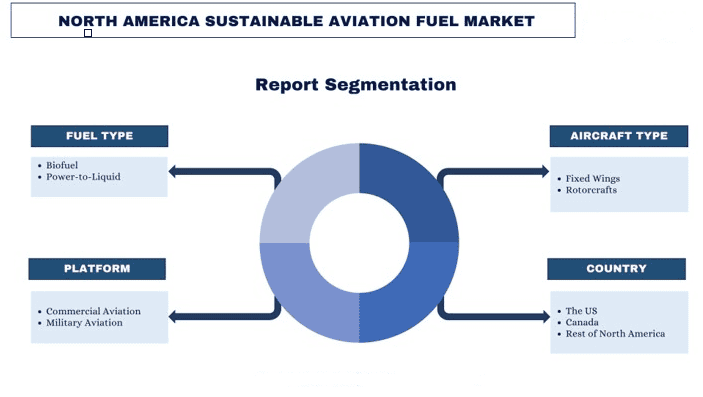
Descripción general de la industria del combustible de aviación sostenible de Norteamérica
El mercado de combustible de aviación sostenible es competitivo y está concentrado, con la presencia de muy pocos actores del mercado norteamericano e internacional. Los actores clave están adoptando diferentes estrategias de crecimiento para mejorar su presencia en el mercado, como asociaciones, acuerdos, colaboraciones, lanzamientos de nuevos productos, expansiones geográficas y fusiones y adquisiciones. Algunos de los principales actores que operan en el mercado son Neste, Fulcrum BioEnergy, World Energy, LLC, TotalEnergies, Gevo, Avfuel Corporation, Aemetis, Inc., Preem AB, SkyNRG, Northwest Advanced Biofuels, LLC.
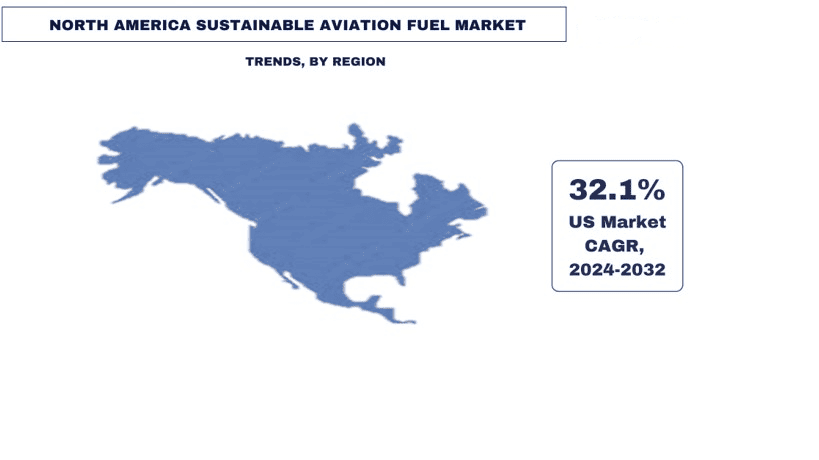
Noticias del mercado de combustible de aviación sostenible de Norteamérica
- En 2023, Airbus utilizó más de 11 millones de litros de SAF en sus operaciones, el doble del volumen de 2022. Esto superó el objetivo de 2023 del 10% del combustible total utilizado en todas las divisiones de Airbus en más de un millón de litros y representó el 2% de todo el SAF producido en todo el mundo. Este logro contribuyó a la reducción de las emisiones de CO2 en 23.587 toneladas.
- Boeing está comprando 9,4 millones de galones (35,6 millones de litros) de combustible de aviación sostenible (SAF) mezclado para apoyar sus operaciones comerciales en EE. UU. en 2024, reduciendo sus emisiones de carbono y trabajando para ayudar a aumentar el suministro de combustible a nivel mundial. Esta es la compra anual de SAF más importante de la empresa, más de un 60% superior a la de 2023.
Cobertura del informe del mercado de combustible de aviación sostenible de Norteamérica
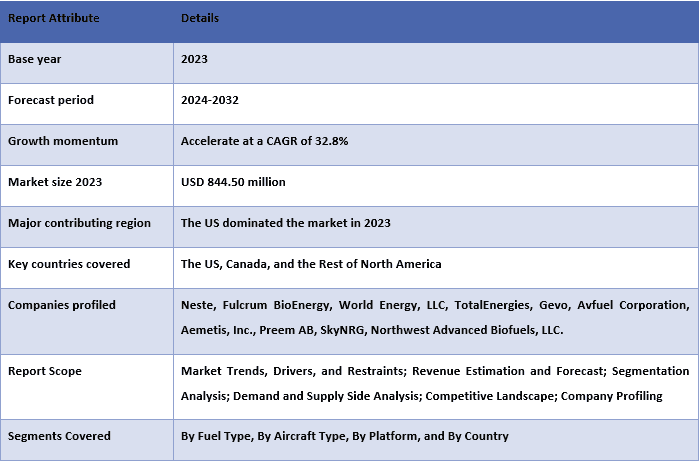
Razones para comprar este informe:
- El estudio incluye el análisis del tamaño y la previsión del mercado validado por expertos clave autenticados de la industria.
- El informe presenta una revisión rápida del rendimiento general de la industria de un vistazo.
- El informe cubre un análisis en profundidad de los pares de la industria prominentes con un enfoque principal en las finanzas clave del negocio, las carteras de productos, las estrategias de expansión y los desarrollos recientes.
- Examen detallado de los impulsores, las restricciones, las tendencias clave y las oportunidades que prevalecen en la industria.
- El estudio cubre de manera integral el mercado en diferentes segmentos.
- Análisis profundo a nivel regional de la industria.
Opciones de personalización:
El mercado de combustible de aviación sostenible de Norteamérica se puede personalizar aún más según los requisitos o cualquier otro segmento de mercado. Además de esto, UMI entiende que puede tener sus propias necesidades comerciales, por lo tanto, no dude en contactarnos para obtener un informe que se adapte completamente a sus requisitos.
Tabla de contenido
Metodología de Investigación para el Análisis del Mercado de Combustible de Aviación Sostenible en Norteamérica (2024-2032)
El análisis del mercado histórico, la estimación del mercado actual y la previsión del mercado futuro del mercado de combustible de aviación sostenible de Norteamérica fueron los tres pasos principales que se llevaron a cabo para crear y analizar la adopción de combustible de aviación sostenible en los principales países. Se realizó una exhaustiva investigación secundaria para recopilar las cifras históricas del mercado y estimar el tamaño actual del mercado. En segundo lugar, para validar estas perspectivas, se tomaron en consideración numerosos hallazgos y supuestos. Además, también se realizaron exhaustivas entrevistas primarias con expertos de la industria en toda la cadena de valor del mercado de combustible de aviación sostenible de Norteamérica. Tras la asunción y validación de las cifras del mercado a través de entrevistas primarias, empleamos un enfoque de arriba hacia abajo/de abajo hacia arriba para pronosticar el tamaño completo del mercado. Posteriormente, se adoptaron métodos de desglose del mercado y triangulación de datos para estimar y analizar el tamaño del mercado de los segmentos y subsegmentos de la industria correspondientes. La metodología detallada se explica a continuación:
Análisis del Tamaño Histórico del Mercado
Paso 1: Estudio en Profundidad de Fuentes Secundarias:
Se llevó a cabo un estudio secundario detallado para obtener el tamaño histórico del mercado de combustible de aviación sostenible a través de fuentes internas de la empresa, como informes anuales y estados financieros, presentaciones de rendimiento, comunicados de prensa, etc., y fuentes externas, incluidos diarios, noticias y artículos, publicaciones gubernamentales, publicaciones de la competencia, informes del sector, bases de datos de terceros y otras publicaciones creíbles.
Paso 2: Segmentación del Mercado:
Después de obtener el tamaño histórico del mercado de combustible de aviación sostenible, realizamos un análisis secundario detallado para recopilar información histórica del mercado y compartirla para diferentes segmentos y subsegmentos para las principales regiones. Los principales segmentos incluidos en el informe son el tipo de combustible, el tipo de aeronave y la plataforma. Además, se llevaron a cabo análisis a nivel de país para evaluar la adopción general en esa región.
Paso 3: Análisis de Factores:
Después de adquirir el tamaño histórico del mercado de diferentes segmentos y subsegmentos, realizamos un análisis de factores detallado para estimar el tamaño actual del mercado de combustible de aviación sostenible. Además, realizamos un análisis de factores utilizando variables dependientes e independientes como el tipo de combustible, el tipo de aeronave y la plataforma del mercado de combustible de aviación sostenible. Se realizó un análisis exhaustivo de los escenarios de demanda y oferta, teniendo en cuenta las principales asociaciones, fusiones y adquisiciones, la expansión comercial y los lanzamientos de productos en el mercado de combustible de aviación sostenible.
Estimación y Previsión del Tamaño Actual del Mercado
Tamaño Actual del Mercado: Basándonos en la información práctica de los 3 pasos anteriores, llegamos al tamaño actual del mercado, los actores clave en el mercado de combustible de aviación sostenible de Norteamérica y las cuotas de mercado de los segmentos. Todos los porcentajes de participación requeridos y los desgloses del mercado se determinaron utilizando el enfoque secundario mencionado anteriormente y se verificaron a través de entrevistas primarias.
Estimación y Previsión: Para la estimación y previsión del mercado, se asignaron ponderaciones a diferentes factores, incluidos los impulsores y las tendencias, las restricciones y las oportunidades disponibles para las partes interesadas. Después de analizar estos factores, se aplicaron técnicas de previsión relevantes, es decir, el enfoque de arriba hacia abajo/de abajo hacia arriba, para llegar a la previsión del mercado para 2032 para diferentes segmentos y subsegmentos en los principales mercados de Norteamérica. La metodología de investigación adoptada para estimar el tamaño del mercado abarca:
- El tamaño del mercado de la industria, en términos de ingresos (USD) y la tasa de adopción del mercado de combustible de aviación sostenible en los principales mercados a nivel nacional
- Todos los porcentajes de participación, divisiones y desgloses de los segmentos y subsegmentos del mercado
- Actores clave en el mercado de combustible de aviación sostenible de Norteamérica en términos de productos ofrecidos. Además, las estrategias de crecimiento adoptadas por estos actores para competir en el mercado de rápido crecimiento.
Validación del Tamaño y la Cuota de Mercado
Investigación Primaria: Se realizaron entrevistas en profundidad con los líderes de opinión clave (KOL) que incluyen ejecutivos de alto nivel (CXO/VP, jefe de ventas, jefe de marketing, jefe de operaciones, jefe regional, jefe de país, etc.) en las principales regiones. Los hallazgos de la investigación primaria se resumieron y se realizó un análisis estadístico para probar la hipótesis establecida. Los aportes de la investigación primaria se consolidaron con los hallazgos secundarios, convirtiendo así la información en información práctica.
División de los Participantes Primarios
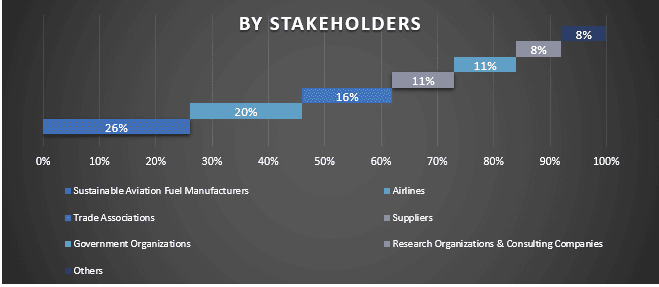
Ingeniería de Mercado
Se empleó la técnica de triangulación de datos para completar la estimación general del mercado y llegar a números estadísticos precisos para cada segmento y subsegmento del mercado de combustible de aviación sostenible de Norteamérica. Los datos se dividieron en varios segmentos y subsegmentos después de estudiar varios parámetros y tendencias en las áreas del tipo de combustible, el tipo de aeronave y la plataforma en el mercado de combustible de aviación sostenible de Norteamérica.
El objetivo principal del Estudio del Mercado de Combustible de Aviación Sostenible de Norteamérica
Las tendencias actuales y futuras del mercado de combustible de aviación sostenible de Norteamérica se identificaron en el estudio. Los inversores pueden obtener información estratégica para basar su discreción para las inversiones en el análisis cualitativo y cuantitativo realizado en el estudio. Las tendencias actuales y futuras del mercado determinaron el atractivo general del mercado a nivel regional, proporcionando una plataforma para que el participante industrial explote el mercado sin explotar para beneficiarse de una ventaja de ser el primero en actuar. Otros objetivos cuantitativos de los estudios incluyen:
- Analizar el tamaño actual y previsto del mercado de combustible de aviación sostenible en términos de valor (USD). Además, analizar el tamaño actual y previsto del mercado de diferentes segmentos y subsegmentos.
- Los segmentos en el estudio incluyen áreas del tipo de combustible, el tipo de aeronave y la plataforma.
- Definir y analizar el marco regulatorio para el combustible de aviación sostenible
- Analizar la cadena de valor involucrada con la presencia de varios intermediarios, junto con el análisis de los comportamientos de los clientes y la competencia de la industria.
- Analizar el tamaño actual y previsto del mercado de combustible de aviación sostenible para la región principal.
- Los principales países de las regiones estudiadas en el informe incluyen Estados Unidos, Canadá y el resto de Norteamérica.
- Perfiles de las empresas del mercado de combustible de aviación sostenible y las estrategias de crecimiento adoptadas por los participantes del mercado para mantenerse en el mercado de rápido crecimiento.
- Análisis profundo a nivel de país de la industria
Preguntas frecuentes Preguntas frecuentes
P1: ¿Cuál es el tamaño actual del mercado y el potencial de crecimiento del mercado de Combustible de Aviación Sostenible en Norteamérica?
P2: ¿Cuáles son los factores impulsores para el crecimiento del mercado de combustible de aviación sostenible?
P3: ¿Qué segmento tiene la mayor cuota del mercado de combustible de aviación sostenible por tipo de combustible?
P4: ¿Cuáles son las tecnologías emergentes y las tendencias en el mercado de combustibles de aviación sostenibles?
P5: ¿Qué país dominará el mercado de combustibles de aviación sostenibles?
Relacionados Informes
Los clientes que compraron este artículo también compraron



